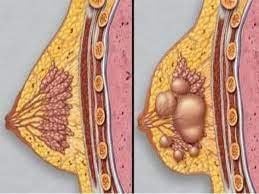This is an automatically translated article.
Milk duct blockages are small, soft lumps in the breast and form in the milk ducts of the breast that block the flow of breast milk. These are common breastfeeding problems and they can cause swelling, redness, and pain in the affected breast area.1. Symptoms of blocked milk ducts
Clogged milk ducts or plugged milk ducts happen when the milk ducts in your breast become blocked. You may experience this if your breasts are not fully drained after breastfeeding, if your baby stops nursing or if you are under stress, which can lead to blocked milk ducts.
Symptoms can come on gradually and usually affect only one breast. You may experience:
A lump in one area of the breast Milk tightness around the lump Pain or swelling near the lump Discomfort that subsides after breastfeeding or pumping Pain from frustration The lump moves over time You also often see a temporary decrease in your milk supply when you are congested. You may even see condensed or fatty milk as you express it. If you do nothing, the blockage will not be able to fix itself. Instead, it can progress to an infection known as mastitis. Note that fever is not a symptom that you will experience with blocked milk ducts. If you have pain and other symptoms along with a fever, it could be a sign you have an infection.
Symptoms of mastitis can come on suddenly and include:
Fever of 101°F (38.3°C) or higher Flu-like symptoms (chills and body aches) Warmth, swelling and pain in the entire breast Breast lump or thickening of breast tissue Burning sensation and/or discomfort while breastfeeding/sucking Rash on the affected skin (may be wedge-shaped) Mastitis affects 1 out of 10 breastfeeding women. If you've had it before, you're more likely to get it again. Untreated mastitis can lead to a collection of pus, a breast abscess that requires surgery to drain the abscess.

Sưng và đau toàn bộ vú có thể gặp khi viêm vú
2. Causes of blocked milk ducts
The root cause of blocked milk ducts is usually something that prevents the breasts from producing milk completely. This can be anything that puts pressure on your breasts, from a sports bra that's too tight or breastfeeding too often.
Clogged milk ducts and mastitis can even be caused by the way you feed your baby. For example, if your child prefers one breast to the opposite, it can lead to a blockage in the less commonly used opposite breast. Nipple problems and pumping problems are also other situations that can promote blocked milk ducts.
There are also certain risk factors that can make you more susceptible to blocked milk ducts and mastitis:
History of mastitis while breastfeeding Cracked skin on the nipples Insufficient diet Smoking Stress and Fatigue Blebs can clog the openings of your milk ducts and cause breast milk to back up and get stuck in the passageways that allow milk to flow from the milk production site in the breast to the nipple. suckling baby. Abundant milk supply: If your body produces too much breast milk, it can lead to engorgement and blocked milk ducts. Dehydration and fatigue: Lack of rest and not drinking enough fluids can put you at risk of developing blocked milk ducts. Exercise: Clogged ducts can result from vigorous or strenuous exercise, especially upper body exercise. Weaning: If the baby is weaned quickly, it can lead to engorgement, blocked milk ducts and mastitis.
3. Should you breastfeed when your milk ducts are blocked?
The answer is yes and you should because this is the best way to clear milk ducts. Clogged ducts can cause discomfort and anxiety. However, blocked milk ducts tend to be easy to treat and can often be managed at home. It is important that you get treatment done early. If left untreated, a blocked milk duct can lead to a breast infection or worsening, so take these steps to get the milk flowing again:
Continue breastfeeding: Not only is breastfeeding safe. with blocked milk ducts, but also the best way to clear the blockage. Feed your baby the clogged breast first (although if it's too painful, you can start with the opposite breast) and make sure your baby finishes the breast at each feeding. Find the right position: Try positions that use gravity to help draw more milk from the breast. Or try to get your baby to latch on so that his chin and nose are facing the blockage, so his suction is aimed directly at the affected milk duct and his chin can also help soothe the area. . Change breastfeeding positions so that all the milk ducts are stimulated equally. Express when needed: If your baby hasn't finished his breast milk yet, pump all of the milk using a breast pump until the milk comes out in slow drips instead of a steady stream. This process only takes a few minutes. Sometimes, blocked ducts are aggravated by external pressure (for example, from a shirt or bra that is too tight). Therefore, you should wear a bra that fits but not tight and consider using an underwire bra for the time being. Warm compress: Place a warm washcloth (dipped the towel in warm water) on the sore breast before each feeding to help the milk flow. Or you can stand under a warm shower, letting the water run down your chest. One of the most effective treatments is breast massage, especially when you are breastfeeding or pumping. To massage, start from the outside of the breast and apply pressure with your fingers as you move towards the nipple. This remedy can also be useful for massaging while you are in the shower. If you have mastitis, you will most likely need antibiotics to treat the infection. The drug can be taken for a period of 10 days. You need to make sure to take all of your medications as directed to prevent mastitis from coming back. Check with your doctor if symptoms continue after you have finished treatment. Over-the-counter pain relievers can also help relieve discomfort and inflammation of breast tissue. Your doctor may prescribe medications such as Tylenol (acetaminophen) or Advil/Motrin (ibuprofen).

Cho con bú là cách tốt nhất để thông ống dẫn sữa
4. When to see the doctor?
Redness or bruising on the breast may persist for a week or longer after you have had mastitis cleared or treated. However, if you are concerned or feel a blockage or infection is not healing, make an appointment with your doctor. In some cases, you may need another course of antibiotics or use additional treatments, such as draining the abscess.
If symptoms persist, your doctor may recommend a mammogram, ultrasound, or biopsy to rule out inflammatory breast cancer. This rare form of cancer can sometimes cause symptoms similar to mastitis, such as swelling and redness.
5. Prevent blocked milk ducts
To prevent blocked milk ducts, you need to make sure to breastfeed or pump regularly. Experts recommend feeding your baby 8 to 12 times a day, especially in the early days of breastfeeding.
You can also try other measures such as:
Massaging your breasts while breastfeeding/suppressing to promote milk flow Limit the use of tight clothing or bras to create space for your breasts you (wear loose clothing is best) Change breastfeeding positions to ensure that suction is evenly distributed across all ducts Warm pre-feeding massage to areas of breasts that tend to become clogged Cooling your breasts after breastfeeding Cracked nipples and milk duct holes can make it easier for bacteria from your baby's skin or mouth to enter your breast, leading to mastitis. So make sure to keep your breasts clean and dry, and possibly use products to protect cracked nipples. Ask for help, take a nap, or go to bed early, even if you know you'll be feeding a few hours later. Overall, do all the self-care to help you avoid feeling depressed. See a lactation consultant. Frequent blockages can be a sign that your baby is not latching on or sucking well.

Người mẹ nên gặp chuyên gia y tế khi cần thiết
Newborns in general are prone to respiratory diseases, respiratory infections and gastrointestinal infections if they are introduced to solid foods early or the storage and preparation of milk is not guaranteed. To protect children's health, parents should do well to exclusively breastfeed their babies for the first 6 months (if possible) and vaccinate on schedule. As soon as the child shows symptoms such as anorexia, fatigue, crying, it is necessary to take the child to the hospital to be consulted by a specialist for monitoring and treatment. The pediatric department at Vinmec International General Hospital is the address for receiving and examining diseases that infants and young children are susceptible to: viral fever, bacterial fever, otitis media, pneumonia in children. With a system of facilities, modern medical equipment, sterile space, minimizing the impact as well as the risk of disease spread, Vinmec will bring satisfaction to customers. and is highly appreciated by industry experts with:
Gathering a team of leading pediatricians: including leading experts with high professional qualifications (professors, associate professors, doctors, Master's degree), experienced, worked at major hospitals such as Bach Mai, 108.. The doctors are all well-trained, professional, conscientious, knowledgeable about young psychology. Besides domestic pediatricians, the Department of Pediatrics also has the participation of foreign experts (Japan, Singapore, Australia, USA) who are always pioneers in applying the latest and most effective treatment regimens. . Comprehensive services: In the field of Pediatrics, Vinmec provides a chain of continuous medical examination and treatment services from Newborn to Pediatric and Vaccine,... according to international standards to help parents take care of their baby's health from birth to children. from birth to adulthood Specialized techniques: Vinmec has successfully deployed many specialized techniques to make the treatment of difficult diseases in Pediatrics more effective: neurosurgery - skull surgery, stem cell transplantation. blood in cancer treatment. Professional care: In addition to understanding children's psychology, Vinmec also pays special attention to the children's play space, helping them to play comfortably and get used to the hospital's environment, cooperate in treatment, improve the efficiency of medical treatment.
Please dial HOTLINE for more information or register for an appointment HERE. Download MyVinmec app to make appointments faster and to manage your bookings easily.
References: babycenter.com, verywellfamily.com, whattoexpect.com













